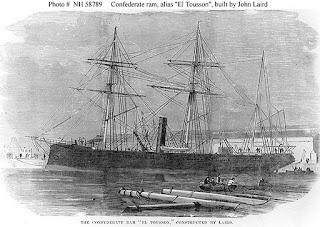'Birkenhead Ram:' Called El Tousson because it was supposedly being bought by Egypt, the ship was seized at the Laird shipyard across the River Mersey from Liverpool in 1863.
Working out of a small office in the impressive mansion of Fraser, Trenholm & Co., the Confederacy's fiscal arm in Great Britain, Bulloch soon made the acquaintance of the Laird Brothers across the River Mersey from Liverpool. The company already was known as a first-rate shipbuilder and a technological pioneer, one that Charles Prioleau, a transplanted South Carolinian and in charge of Fraser, Trenholm in Liverpool had already done business with. He bought blockade-runner Herald and possibly a few others early in the war to operate out of the company's home port of Charleston, S.C.
The firm's name reflected its history. Its offices were spacious and stately. Fraser had long since left the Liverpool enterprise, and George Trenholm, a future Confederate Treasury secretary, was one of the wealthiest men in the South.
In late 1861, Bulloch presented the Lairds with a design for a wooden screw steamer capable of cruising at 13 knots. On paper, the 210-foot vessel could be a special merchantman or it could be what it really was destined to be the Conferacy's second commerce raider. He expected to delivery in the spring of 1862.
Bulloch consistently denied that John Laird, who left the active business for a seat in Parliament in 1860, or any of his sons knew that "No. 290," the 290th ship on their order books, was a warship, violating Great Britain's Neutrality Proclamation concerning the war in North America and its Foreign Enlistment Act. The denial seems a stretch, particularly in light of other business the yard conducted with the Confederacy, all through subterfuges.
Who were these Lairds and their shipbuilding company courted and cursed by the United States for building CSS Alabama and the rams and cmbraced by the Confederacy?
The Napoleonic wars catapulted the Lairds into a leading position among Scotland's maritime businesses. They soon cast about for ways to expand the family business of ropeworks and niche elements of shipbuilding. When the first William Laird arrived in Liverpool, the thirty-year-old was like a number of young Scots trying their business hand across the gamut of maritime commerce still open in Great Britain's busiest Atlantic port. The Channel ports were threatened from the start by invasion.
When the wars finally ended in 1815, William moved the family business into new ventures. By 1822, he was a stockholder in the St. George Packet Co., offering steamer service between Liverpool and Glasgow. Soon enough, the company expanded its service to Dublin and other ports on the Irish and North Seas.
But the most important step William Laird took occurred in 1824 when he, John Hamilton and John Forsyth -- "all clever men" -- bought a sandy strip of riverfront property in a fishing village of fifty souls across from Liverpool for a rew hundred pounds. Laird's plans for Birkenhead were grand -- an ironworks first and then a shipyard "less tied by the trammels of old thinking."
Early on, the Lairds were committed to large vessels, using iron, propelled by steam and screw propellers. New ideas flowed into their yard like the twice daily tides. For instance, William Laird worked with John Ericsson on a steam wheel and rotary steam engine; and one of its first vessels was the Robert F. Stockton, built on the order of the rich American naval officer of the same name. Stockton was the principal force behind the American Navy's screw propeller Princeton.
By the late 1830s, Laird and Sons, the company's name changed several times before the Civil War, was building ships for East India Company, transatlantic steamers, gunboats for duty on the Tigris and Euphrates rivers, small vessels and warships for the Royal Navy, and a paddle-wheeler for the Mexican Navy.
When the Crimean War began in the mid-1850s, the grandsons were monitoring French shipbuilding techniques in Toulon and the British fleet's performance on the Black Sea. The company with its 2,000 workers was ready for the Admiralty's buy orders for a fleet of ironclads in its "new yard" immediately after the fighting ceased.
Business again was booming.
When John Laird left for Parliament, he proudly announced Laird and Sons was in capable hands with a worldwide reputation of quality and innovation.
The yard's work with the Confederacy started small with Prioleau's order for a blockade runner, paid for out of Fraser, Trenholm's funds; but as the war dragged on, Bulloch with the Confederate Navy's orders plus credit from Fraser, Trenholm promised more work -- all done through false fronts and masked buyers.
While Charles Francis Adams, the Union minister to Great Britain, and Thomas Haines Dudley, the Union consul in Liverpool filed objection upon objection with British customs officials, the Royal Navy, and Foreign Minister John Russell about Laird's work with the Confederacy, Gustavus Fox, the Union's assistant secretary of the Navy, looked for ways to do business with the yard -- using his own false end-buyers.
Likely the thinking among the Lairds was: Someone had to profit from a civil war. Why shouldn't it be one of the world's premier shipyards, theirs?

0 comments:
Post a Comment